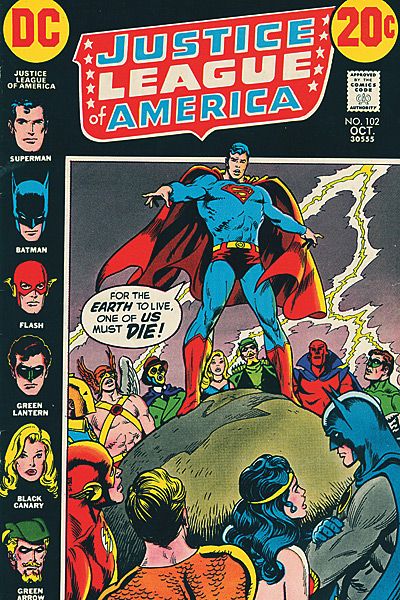Showcase Presents Justice League of America 5
Reviewed by Martin Skidmore 28-Feb-11
This collection, reprinting JLA 84-106, 1970-73, is not one of the better periods for the JLA. I love the team and several of its members, but it has to be faced that it has had plenty of crappy periods. After the charming and fun, if very trivial, early stories by Fox & Sekowsky, by now it is trying to be more Marvel and more ‘relevant’ as the term was then.
This collection, reprinting JLA 84-106, 1970-73, is not one of the better periods for the JLA. I love the team and several of its members, but it has to be faced that it has had plenty of crappy periods. After the charming and fun, if very trivial, early stories by Fox & Sekowsky, by now it is trying to be more Marvel and more ‘relevant’ as the term was then. This means socially conscious and engaged, so we get stories with hippies and environmental problems and so on. Unfortunately these are all terrible, largely thanks to Friedrich’s immensely clumsy writing.
As Grant Morrison grasped so superbly, one of the first duties when writing as mighty a team is this is creating credible threats. This job is failed hopelessly for the most part – there is a powerful cosmic vampire, but he’s a bore and the victory is pretty inexplicable. The rest are minor league nuisances, or the JLA’s approaches are incompetent and often idiotic – making good use of the team’s resources is the flipside of that first duty, and this is very poorly done.
Another need is to do interesting things with the characters. Admittedly that is a tightly limited opportunity when most of them have their own titles, but for instance Black Canary is featured regularly, but barely uses her powers, instead being largely played as love interest for a whole string of characters, briefly including Batman. There’s no Wonder Woman (she was in her powerless Diana Prince era) and no Martian Manhunter (doing something on Mars).
Dick Dillin was never a bad artist – he draws what is asked of him and moves the narrative along smoothly – but I don’t think he drew an exciting panel in his entire career, and this isn’t helped by Giella’s very basic inking. I’ve never been a fan of Neal Adams’ comics work, but his several covers here, and indeed four pages within one story featuring Deadman, really highlight how dull the bulk of the art is.
The collection does get a little better at the end: Len Wein’s stories are more purposeful and coherent (though the menace in his JSA crossover is lame, and his endings lack drama), and less hamfistedly preachy, and Dick Giordano’s inks are a huge improvement. Nonetheless, I recommend the first three volumes of this series, while Sekowsky was drawing it, and I wouldn’t suggest bothering with this one unless you are a very big JLA fan. I’m reluctant to come to such a conclusion, as I am disappointed that the Showcase publication schedule has slowed down so much, but I couldn’t in good conscience encourage readers to buy this one.
Tags: DC, Dick Dillin, JLA, Joe Giella, Len Wein, Mike Friedrich, Showcase